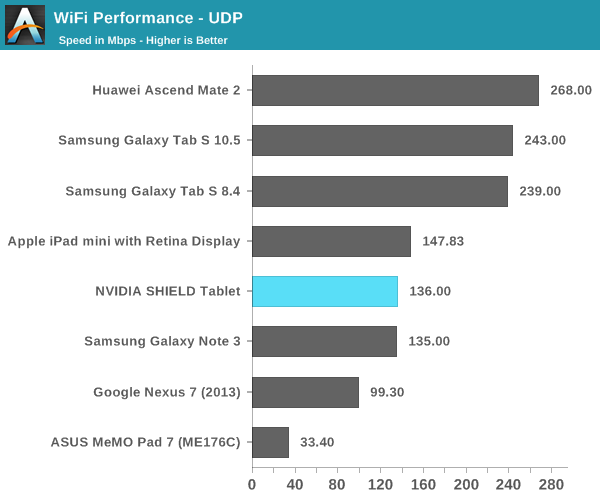The NVIDIA SHIELD Tablet Review
by Joshua Ho on July 29, 2014 9:00 AM ESTWiFi Performance
For the most part these days it seems that the situation for WiFi is much better in mobile than it is anywhere else, but it's still important to test throughput, especially on a device like the Shield tablet that requires low latency, high bandwidth connections in order to support GameStream and GRID. To this end, while NVIDIA hasn't shipped 802.11ac the Shield tablet ships with a 2x2 antenna configuration for a maximum PHY rate of 300 Mbps. Like the Shield portable, this is a BCM43241 chip, likely shared to improve economies of scale. To look at how it performs, we turn to iperf. Before we get into the results of the test, I'd like to thank ASUS for providing the RT-AC68U router to test WiFi perfomance.

Surprisingly, the Shield tablet performs about as well as some single stream 802.11ac solutions like the one found in the Galaxy Note 3. Performance is generally in line with what we'd expect for such a solution, although it would be nice to see 802.11ac for future products.
Camera
While I currently don't have the means to properly test camera, there are still some things to talk about for camera. Both the front and rear camera modules use OmniVision's OVT5963 sensor, which appears to be a 1/4", 5MP sensor. The rear camera has an F/2.0 aperture with 2.95mm focal length, and the front camera has an F/2.8 aperture, with a claimed 4.76mm focal length, although the field of view appears to be somewhat wider. This is the same sensor as the camera in the Nexus 7 (2013). As a rear facing camera, the quality is nothing special but as a front facing camera it's surprisingly high quality. The photo above is with the rear facing camera, the photo below is from the front facing camera. The stock camera application also doesn't show the correct aspect ratio for the camera, so the preview is cropped.
Audio
While I don't have the equipment available to test audio quality and peak volume quite yet, subjectively the two bass reflex ports and dual front facing speakers make for a great experience. It's definitely a major advantage over other devices when it comes to watching movies and playing games as I don't have to cup my hand around the speaker. The larger size of the tablet formfactor means that the stereo separation is much more obvious. On the headphone jack, the device appears to be using a Realtek RT5639 codec. It seems that NVIDIA has continued to use their own speaker protection system that runs on the SoC, as there isn't any clear evidence of a speaker protection IC connected via I2C.












174 Comments
View All Comments
TheJian - Wednesday, July 30, 2014 - link
Full 3.1 ES support and OpenGL 4.4. Being based on desktop gpus it should become a very good emu platform over time. I wonder if a 20nm M1 would be totally able to play wiiu games too? I find myself wanting to hold out for a 20nm version of NV's chip for a serious boost in power for gaming since android seems to be really taking off in this area. I couldn't justify a tablet before just as a tablet, but my list of android games I want to play is growing so might have to bite soon. Dad's nexus 10 isn't good enough for many things (dang res being too high). I hope NV sticks with 1080p/1200p for a while so gaming just gets better not slower on android. Above this is just stupid in something under 13in with gaming as an intention.Another review showed it running emus and Zelda Ocarina of time.
http://gizmodo.com/nvidia-shield-tablet-review-a-g...
Mupen64. Dolphin guys will probably adapt it to K1 soon I'd guess. The power and features are there. N64 games work at least according to gizmodo guy. I'm not really interested in anything before n64's time but there's some pretty fun stuff on n64 or better I wouldn't mind playing today (never owning any nintendo product previously).
Knowname - Wednesday, July 30, 2014 - link
the controller is certainly as uncomfortable as an n64's *bazinga*NZtechfreak - Monday, August 18, 2014 - link
Dolphin will run, on time trial mode (no other racers onscreen) in Double Dash it gets 40-60fps, with high 40 to high 50s the majority of the time. Haven't yet tried a lot of other stuff. The Dolphin developers are really looking forward to the 64-bit K1.bossmoogle - Tuesday, July 29, 2014 - link
I'm considering one of these but for me an important factor that wasn't discussed in the review was the glass on the display. I'm guessing it's not GorillaGlass. Is it scratch resistant at all? I'm on a Nexus 7 2013 right now and the GOrillaGlass is just amazing, if I wipe my screen off it still looks pristine as if it had just gotten off the assembly line. Not a single micro scratch is visible in the sunlight. Once you've used something like that it's very hard to go back to a screen you know is going to get all scratched up.schizoide - Tuesday, July 29, 2014 - link
The nexus7 2013 actually uses Corning's "Fit" or "Concore" glass, which is not as scratch resistant as corning gorilla glass.I researched it briefly but was unable to find what the shield tablet uses. So I agree that it's probably not gorilla glass, or they would have said so.
kron123456789 - Tuesday, July 29, 2014 - link
Good thing about games on this tablet is that Tegra K1 optimized games are using desktop OpenGL, not mobile OpenGL ES.kidconcept - Tuesday, July 29, 2014 - link
> Of course, the real question here is whether the gaming side is worth the price premium.Can you mention some other tablets the Shield has to compete with on price? For example, the Nexus 7 costs about $60 dollars more than the Shield (16GB +$70, 32GB-LTE +$50). Anything else in the same class as the Shield that is significantly cheaper?
Great review BTW. Hit all the important points for most of the audience. As an artist, I'm curious about how the stylus performs, but I recognize that nobody else really cares about it.
schizoide - Tuesday, July 29, 2014 - link
You've got that backwards. The Nexus 7 16GB retails for $230 and the Nexus 7 32GB model with LTE at $350.The nvidia shield tablet 16GB retails for $300, and the 32GB model with LTE will sell for $400.
schizoide - Tuesday, July 29, 2014 - link
Also like I posted earlier, if you're OK with manufacturer refurbs, you can pick up a N7 16GB refurb from an authorized reseller for $140 on eBay. Half the price.kidconcept - Tuesday, July 29, 2014 - link
Refurbs isn't really a great price comparison.